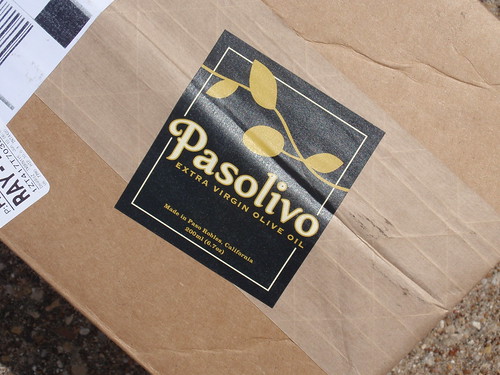Pasolivo’s Extra Virgin Olive Oil, made in beautiful Paso Robles, California, has justified my entire Project Olive Oil. In a word, it is outstanding.
It is also expensive, but I think the price is worth it. I first tried Pasolivo in July of 2010 when I ordered a few bottles. Although there are stores that carry Pasolivo’s olive oils, those stores are nowhere near me, so mail-ordering was my best option. I bought three bottles: two bottles of the Tuscan blend and one of the tangerine oil. I kept a Tuscan and the tangerine for me, and the second Tuscan was a gift for Matt, with whom I visited Paso Robles so long ago. Each bottle was 200 milliliters, which is about 6.8 ounces. For 15 dollars a bottle (on sale!), you get what amounts to less than a cup of oil. We’re talking fancy-pants gourmet prices here. Is this oil worth that kind of money? Absolutely. But I have to add that I think the prices have come down a little bit. Pasolivo has new packaging now: a tin containing 375 milliliters (~12.7 ounces) of the California oil is currently selling for twenty-two dollars. So let’s do the math:
Old price: $15/6.8 ounces = $2.21 per ounce
New price: $22/12.7 ounces = $1.73 per ounce
See? Better prices now! Of course, if you’re like me, you have to pay for shipping, but I’m going to set that issue aside for now because your shipping price will depend on where you live and how much olive oil you order. Okay, math lesson over. There will be a quiz next week, so bring your calculators and your number two pencils.
Back to the olive oil. I’ve become such a rebel lately in the kitchen; I don’t know what’s gotten into me. While I was cooking with Pasolivo, I threw out all my Project Olive Oil tasting guidelines. I just cooked what I felt like eating, and if it seemed like a good candidate for some fancy olive oil, I uncorked the Pasolivo. I nursed my bottle of Tuscan blend for several months, and during that time, I did try a variety of dishes with it: salads, simple bean-and-vegetable dishes, tomatoes and fresh mozzarella sprinkled with salt and drizzled with olive oil. But my Pasolivo never saw the inside of an oven: it seemed like a waste to bake with such an expensive oil. I could, however, imagine blending Pasolivo with a less expensive oil to add some depth of flavor. I’ll have to save that idea for next time, as I am currently waiting on the arrival of my 2011 Pasolivo order.
Pasolivo’s Tuscan blend has a flavor that is not all that different from the other olive oils I’ve tried during Project Olive Oil. It’s fruity and grassy, and it smells great, like the perfect summer day poured into a glass bottle. The way in which Pasolivo stands apart from those other oils is with its intensity: there is more flavor packed into each drop of olive oil, which I think is why these expensive oils are recommended as “finishing” oils—the kind you drizzle on top of your soup or fresh tomatoes, just a tiny bit to make your meal transcendent. In this way, the olive oil reminds me a bit of other potent garnishes, like fresh herbs or a judicious grind of fresh black pepper. It’s those little touches that make cooking an art and a pleasure.
In my mental cooking catalogue of ingredients, Pasolivo’s olive oils belong in that category of “tasty extras,” along with the fresh herbs, sprinkles of freshly grated Parmesan, or dabs of sour cream. These lovely flourishes won’t make or break your meal, but they add a lot of flavor for very little effort. I often have a hard time remembering these things, especially on weeknights when I’m tired and hungry and just want to eat something, anything. I can recommend cooking with Pasolivo in situations where you need one or two tablespoons of oil for a dish, but if you need more, I’d recommend using a few tablespoons of the good stuff and making up the difference with something a little less pricey. The flavor of Pasolivo will come through, and you’ll be able to enjoy your oil for a little longer before shelling out for a new bottle or two.


No comments:
Post a Comment